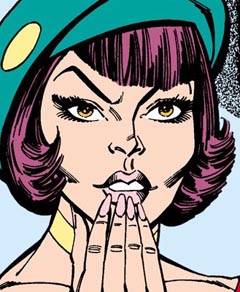Springing from “Tales of the TMNT” Volume 2 came four four-issue miniseries, one featuring each Turtle. “Leonardo: Blind Sight” (2006) launches from Issue 5, where Leo gets temporarily blinded by a Shredder Elite and accidentally kills a homeless man, and “Raphael: Bad Moon Rising” (2007) grows out of Issue 7, where Raph saves rebellious teen Shadow from a werewolf cult.
“Michelangelo: The Third Kind” (2008) takes place in the six-month gap during “TMNT” Volume 4, Issue 5, when humanity deals (very poorly, it turns out) with the peaceful alien visitors, while “Donatello: The Brain Thief” (2009) takes us back to the “TMNT” Volume 2 era to deal with the last vestiges of Baxter Stockman’s villainy.
Not stronger alone
I don’t have all the “Leonardo” issues yet, so I’ll refrain from reviewing that one for now, but the other three strike me as having a weakness that also occasionally plagued the individual Turtles’ one-issue microseries back in the 1980s: There’s not as deep of character exploration as a reader would hope for, and we actually miss the other three Turtles rather than enjoying the chance to focus on one of them. Furthermore, the excuses for why the three other brothers are missing are always lame.

“Raphael: Bad Moon Rising” (2007)
Four issues
Writer: Bill Moulage
Pencils: Jim Lawson
Inks: Eric Talbot
In “Raphael: Bad Moon Rising,” they’re gone due to “a tale as-yet-untold,” a footnote explains (more like a tale never to be told). In “Michelangelo: The Third Kind,” Mike happens to strike up a friendship with the Utrom Klag, but there’s no good reason why he leaves his bros out of the adventure.
“Donatello: The Brain Thief” is the most egregious solo mission, because Don really could’ve used Mike, Leo and Casey’s help in fighting Terminator-esque Baxter offshoots (Raph was kidnapped by D.A.R.P.A. at the time, but the gang was lacking in leads to his whereabouts and should’ve been free to help Don).
“Raphael”
Bill Moulage’s “Raphael” is the weakest of the three miniseries I’ll review here, as the author takes advantage of the Turtle-verse’s storytelling flexibility to create his own “Harry Potter”-lite Nocturna City, accessible via magic and populated with werewolves and one-eyed soul-sucking flying creatures and sentient sea creatures with underwater metropolises.
I guess I’m somewhat hypocritical when it comes to fantasy worlds: I’ll devour “Star Wars” guidebooks or tomes about the monsters of “Buffy,” but that’s after I’ve already been sucked in by story and character.
Nocturna City just never wins me over, perhaps because – like Raph and Shadow – I don’t really like their guide, the werewolf Sloane (She’s a bad influence on Shadow, as the cliché goes). The saving grace of “Bad Moon Rising” is that Raph and Shadow — showing off her ninja skills for the first time outside of a brief hint in Volume 4 — are present, but I really don’t care about the conflict or the other characters – even the cute little witch girl who warps them into Nocturna City and provides lots of helpful accessories, such as protective bubbles.

The best thing I can say about “Bad Moon Rising” is that it is much more tolerable than “Bodycount.”
“Michelangelo”
“Michelangelo,” by Jim Lawson (who also provides the art for all four of these miniseries), is a decided step up as it explores humanity’s reactions to the Utrom visit. Even though the Utroms and their alien friends are careful to be non-threatening every step of the way, many Americans – notably those aligned with the Madhattan Maulitia and H.A.A.R.M. (Humans-Against-Aliens Resistance Movement) – are disappointed that the president doesn’t order a nuclear strike against the island/spaceship that landed in New York harbor.
(Surprisingly, the politicians actually behave very responsibly in the wake of First Contact. I think, in reality, government is more likely than the citizenry to turn a peaceful alien visit into all-out war.)

“Michaelangelo: The Third Kind” (2008)
Four issues
Writer: Jim Lawson
Pencils: Jim Lawson
Inks: Jim Lawson
Issue 1 ends with a paranoid kid shooting his mom after seeing a vision of her as an alien. Bizarrely, while Lawson does feature a police detective as a character, this mysterious twist isn’t followed up on, nor is an early tease about the aliens possibly helping the human race find a cure for cancer.
Ultimately, the threat is dissipated when a H.A.A.R.M. bigwig gives a speech to his followers about how he’s changed: “I ask you to put aside your preconceptions and open your minds. Since children, we are taught to be cynical and mistrust. This robs us of our future. This dooms us to make the same mistakes over again. … We have always reacted in the same ancestral way – to fight. It is my hope to be a new beginning.”
Although it turns out that this was Mikey’s Utrom pal Klag, who had shape-shifted into the H.A.A.R.M. leader, the speech does allow us to imagine how much good could be done if a powerful opinion leader suddenly shifted their position, such as the Federal Reserve chair suddenly grasping Austrian economics or the Department of Defense saying it will end its contracts with Lockheed Martin. Or maybe people would just shift to whatever other opinion leader popped up with the views they favor.
At any rate, while “The Third Kind” has some weird narrative dead-ends, it at least provides food for thought. Generally, I think Peter Laird’s Volume 4, Lawson’s “The Third Kind” and the various side stories take a thoughtful, detailed approach to showing how humanity would react to an alien visit – and that’s key to making this major “TMNT” arc a cut above the clichéd First Contact yarn.
“Donatello”
Both “Bad Moon Rising” and “The Third Kind” are decompressed stories – they feature big panels, lots of wordless fights and a general sense that it all could’ve been wrapped up in fewer issues – but Lawson’s “The Brain Thief” – which easily could’ve been one issue instead of four — takes this to a whole ‘nother level. The “Donatello” series at least provides an important element that the writers of Volume 3, Issues 24-25 would utilize to make Donnie normal again and link up Volumes 3 and 4.

“Donatello: The Brain Thief” (2009)
Four issues
Writer: Jim Lawson
Pencils: Jim Lawson
Inks: Jim Lawson
Throughout “The Brain Thief,” Don stalks the sewers and fights Terminator-like offshoots of the organic metal from the Baxter Stockman robot, and this metal will later be key in Don’s transformation from cyborg back to fully organic. But this series is not the mind-trip it should’ve been.
I would’ve gladly taken panel after panel of Baxter taunting Don about the value of being free from the constraints of humanity rather than what we do get, which is – thematically and character-wise – pretty much zilch.
Final thoughts
I’m not entirely complaining about the decompressed nature of these miniseries, because I am a fan of Lawson’s art and I kind of enjoy exploring the nooks and crannies of the sewers with Don in “The Brain Thief,” and the xenophobia of “The Third Kind” is at least a worthwhile topic.
And even “Bad Moon Rising” has its moments, be them few and far between. (I chuckled with Raph says “Good thing I already barfed” and a footnote tells us “See last issue.”)
But it is frustrating considering that these pages could’ve been spent on something more substantial. Don’t get me wrong: Throughout the nearly 30 years of Mirage “TMNT” comics, the writers did a great job of building Leo, Raph, Mike and Don into distinctly likable, flawed “human” (so to speak) characters.
It’s just odd that the titles with the individual Turtles’ names on them are rarely the issues that do it best.

